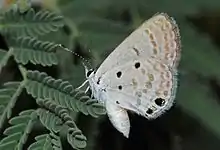Luthrodes galba
Luthrodes galba, the Persian grass blue,[1] is a butterfly in the family Lycaenidae. It is found in southern Turkey, central and eastern Arabia, Iraq, Iran, Afghanistan,[2] the Caucasus and Cyprus.
| Luthrodes galba | |
|---|---|
 | |
| Scientific classification | |
| Kingdom: | |
| Phylum: | |
| Class: | |
| Order: | |
| Family: | |
| Genus: | |
| Species: | L. galba |
| Binomial name | |
| Luthrodes galba | |
| Synonyms | |
| |
The larvae feed on Prosopis stephaniana, Lagonychium farctum, Acacia leucophloa, Acacia campbeli and Lagonichium farctum. They are associated with the ant species Monomorium gracillium.
_(8145300222).jpg.webp)
Description from Seitz
Z. galba Led. (77 k). Above almost exactly like lysimon in both sexes, beneath strongly recalling species of Azanus, especially in the arrangement and development of the black spots; the forewing beneath bears also some similarity to Chilades trochylus, with which galba moreover agrees in size. It is very easily separated from trochilus by the absence of red and blue submarginal dots. — Syria, said to occur also in Egypt, being mentioned, e. g., from Ismailia on the canal of Suez.[3]
Subspecies
- Luthrodes galba galba (Caucasus Minor, highland of Armenia, Talysh Mountains)
- Luthrodes galba phiala (Grum-Grshimailo, 1890) (Kopet-Dagh, southern Ghissar)
References
| Wikimedia Commons has media related to Luthrodes galba. |
| Wikispecies has information related to Luthrodes galba. |
- Luthrodes at Markku Savela's website on Lepidoptera
- "Afrotropical Butterflies: Lycaenidae - Tribe Polyommatini (part 1)". Archived from the original on 2013-12-13. Retrieved 2012-07-16.
- Seitz, A. ed. Band 1: Abt. 1, Die Großschmetterlinge des palaearktischen Faunengebietes, Die palaearktischen Tagfalter, 1909, 379 Seiten, mit 89 kolorierten Tafeln (3470 Figuren)